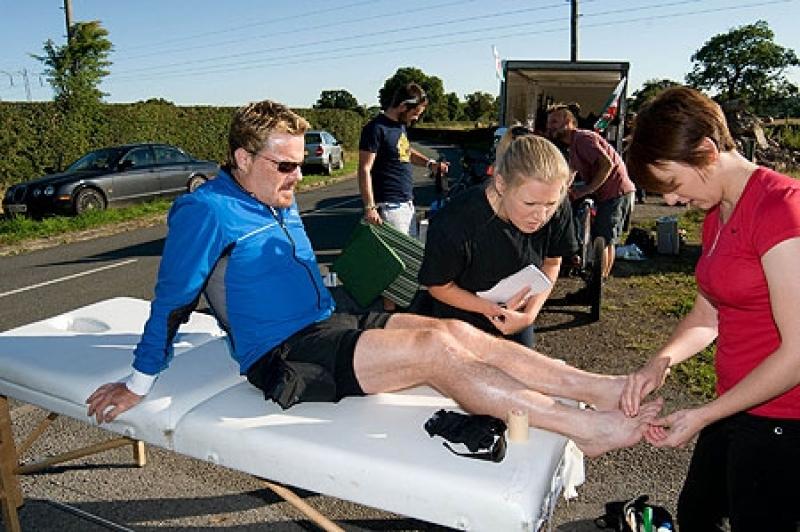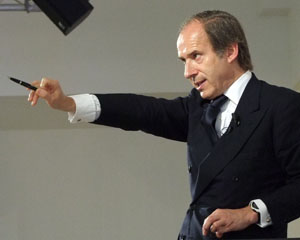Eddie Izzard: Marathon Man, BBC Three / The Man with the Golden Gavel, BBC Four | reviews, news & interviews
Eddie Izzard: Marathon Man, BBC Three / The Man with the Golden Gavel, BBC Four
Eddie Izzard: Marathon Man, BBC Three / The Man with the Golden Gavel, BBC Four
Earnest comedian runs for his life, and Swiss auctioneer hits funding shortfall

Is Eddie Izzard running a lot of marathons really worth three hour-long documentaries? No, but it was worth watching this first one.
Tests revealed that Izzard scored pretty well for stamina, but had flat feet, a string of previous injuries liable to flare up under pressure, and a stocky body shape not optimised for distance-running. Weirdly, none of this seemed to bother him much. Professor Greg Whyte signed on as Eddie’s personal trainer, and he seemed to hit the nail on the head with his comment that attitude was as crucial as physical aptitude in sporting challenges of this nature. Before long, as he flogged his way out of London towards Staines, Basingstoke and Devizes, Izzard was also discovering the truth of the Prof’s observation that “being a competitive athlete is fundamentally miserable.” Thudding along endless stretches of tarmac in pouring rain, Izzard was suffering man-sized doses of that loneliness synonymous with long distance runners.
After forcing his creaking body to grind out those marathon-sized miles, he had to undergo agonising bouts of post-match therapy with Jo, his sports therapist, as she drained fluid from his hideous array of blisters. There is, we gathered, something called an “IT band”, a chunk of fibrous tissue running down the outside of the leg. Eddie’s had become inflamed, and Jo’s massages had him biting pillows in anguish.
Naturally there was plenty of acting involved, and Izzard was happy to play along with psychobabbling analyses of his motives for undertaking such a reckless stunt. One of his key objectives was to run to Skewen in South Wales, and to revisit the house where he lived in 1968 when his mother died. As Matthew Parris pointed out in his Radio Times interview with Izzard, he’s terribly serious for a comedian (“almost off-puttingly earnest”, in fact). We saw this vividly in Izzard’s ability to run while voicing aloud the theory that he was trying to get back to the idyllic childhood he experienced before the Reaper intervened. But, even if his pace was incredibly slow and he kept stopping to drink beer, eat ice-cream and watch the ducks on a nearby pond, you had to admire his bloody-minded obstinacy.
 The motivations of celebrity auctioneer and Swiss baron Simon de Pury (pictured right) were more difficult to read in The Man with the Golden Gavel. The Evening Standard’s art critic Godfrey Barker, who appears to have inherited both his job and his elaborately tooled accent from Brian Sewell, raved about how de Pury was “just so towering an actor”, so much so that one couldn’t differentiate the character he played from the man himself. Yet film of de Pury, owner and chief auctioneer of Phillips auction house, as he cajoled bids from his morbidly wealthy clientele, failed to bear this out. The problem was that the credit crunch arrived in the midst of director Malcolm Neaum’s shooting schedule, leaving de Pury stranded as the pecuniary tide went out.
The motivations of celebrity auctioneer and Swiss baron Simon de Pury (pictured right) were more difficult to read in The Man with the Golden Gavel. The Evening Standard’s art critic Godfrey Barker, who appears to have inherited both his job and his elaborately tooled accent from Brian Sewell, raved about how de Pury was “just so towering an actor”, so much so that one couldn’t differentiate the character he played from the man himself. Yet film of de Pury, owner and chief auctioneer of Phillips auction house, as he cajoled bids from his morbidly wealthy clientele, failed to bear this out. The problem was that the credit crunch arrived in the midst of director Malcolm Neaum’s shooting schedule, leaving de Pury stranded as the pecuniary tide went out.
Still, Neaum successfully evoked a world where familiar laws of logic and common sense had ceased to apply. De Pury’s fetish is for “wet art”, or new works by cutting-edge artists. This may mean Damien Hirst pieces which sell for £4million, or a bin full of motorised garbage by New York “urban artist” David Ellis (“I see great commercial potential,” de Pury exclaimed), or a small ball of “fecal matter” from Tom Friedman. De Pury sold this last artefact for $42,000, but as the commentary noted, “that was before the bottom fell out of the market.”
As the financial slump ground on, things kept getting bleaker, though seeing the kind of people who inhabit de Pury’s world, this seemed nothing more than healthy natural selection. With sales falling by 90 per cent, de Pury had to be propped up by a group of hatchet-faced Russian investors, and even his pioneering line in hideous plastic toys, including a plastic killer tomato and a purple Godzilla, had to be axed. Yet he remained remarkably cheerful – he’s probably got millions stashed away in Zurich, after all – and has diversified into reality TV and a bit of DJ’ing. “Of course the sun is going to come back at some stage,” he bubbled. In this particular case, do we really give a...?
The future of Arts Journalism
You can stop theartsdesk.com closing!
We urgently need financing to survive. Our fundraising drive has thus far raised £49,000 but we need to reach £100,000 or we will be forced to close. Please contribute here: https://gofund.me/c3f6033d
And if you can forward this information to anyone who might assist, we’d be grateful.

Subscribe to theartsdesk.com
Thank you for continuing to read our work on theartsdesk.com. For unlimited access to every article in its entirety, including our archive of more than 15,000 pieces, we're asking for £5 per month or £40 per year. We feel it's a very good deal, and hope you do too.
To take a subscription now simply click here.
And if you're looking for that extra gift for a friend or family member, why not treat them to a theartsdesk.com gift subscription?
more TV
 Murder Before Evensong, Acorn TV review - death comes to the picturesque village of Champton
The Rev Richard Coles's sleuthing cleric hits the screen
Murder Before Evensong, Acorn TV review - death comes to the picturesque village of Champton
The Rev Richard Coles's sleuthing cleric hits the screen
 Black Rabbit, Netflix review - grime and punishment in New York City
Jude Law and Jason Bateman tread the thin line between love and hate
Black Rabbit, Netflix review - grime and punishment in New York City
Jude Law and Jason Bateman tread the thin line between love and hate
 The Hack, ITV review - plodding anatomy of twin UK scandals
Jack Thorne's skill can't disguise the bagginess of his double-headed material
The Hack, ITV review - plodding anatomy of twin UK scandals
Jack Thorne's skill can't disguise the bagginess of his double-headed material
 Slow Horses, Series 5, Apple TV+ review - terror, trauma and impeccable comic timing
Jackson Lamb's band of MI5 misfits continues to fascinate and amuse
Slow Horses, Series 5, Apple TV+ review - terror, trauma and impeccable comic timing
Jackson Lamb's band of MI5 misfits continues to fascinate and amuse
 Coldwater, ITV1 review - horror and black comedy in the Highlands
Superb cast lights up David Ireland's cunning thriller
Coldwater, ITV1 review - horror and black comedy in the Highlands
Superb cast lights up David Ireland's cunning thriller
 Blu-ray: The Sweeney - Series One
Influential and entertaining 1970s police drama, handsomely restored
Blu-ray: The Sweeney - Series One
Influential and entertaining 1970s police drama, handsomely restored
 I Fought the Law, ITVX review - how an 800-year-old law was challenged and changed
Sheridan Smith's raw performance dominates ITV's new docudrama about injustice
I Fought the Law, ITVX review - how an 800-year-old law was challenged and changed
Sheridan Smith's raw performance dominates ITV's new docudrama about injustice
 The Paper, Sky Max review - a spinoff of the US Office worth waiting 20 years for
Perfectly judged recycling of the original's key elements, with a star turn at its heart
The Paper, Sky Max review - a spinoff of the US Office worth waiting 20 years for
Perfectly judged recycling of the original's key elements, with a star turn at its heart
 The Guest, BBC One review - be careful what you wish for
A terrific Eve Myles stars in addictive Welsh mystery
The Guest, BBC One review - be careful what you wish for
A terrific Eve Myles stars in addictive Welsh mystery
 theartsdesk Q&A: Suranne Jones on 'Hostage', power pants and politics
The star and producer talks about taking on the role of Prime Minister, wearing high heels and living in the public eye
theartsdesk Q&A: Suranne Jones on 'Hostage', power pants and politics
The star and producer talks about taking on the role of Prime Minister, wearing high heels and living in the public eye
 King & Conqueror, BBC One review - not many kicks in 1066
Turgid medieval drama leaves viewers in the dark
King & Conqueror, BBC One review - not many kicks in 1066
Turgid medieval drama leaves viewers in the dark
 Hostage, Netflix review - entente not-too-cordiale
Suranne Jones and Julie Delpy cross swords in confused political drama
Hostage, Netflix review - entente not-too-cordiale
Suranne Jones and Julie Delpy cross swords in confused political drama

Add comment